

Modo still always maps the image to the 0-1 space of the UV grid. Images can be any size, any aspect ratio, and any resolution. The UV window is square, so you may assume that UV-mapped images need to be square as well. Modo has no specific contraints regarding the position of geometry within UV space.Ī possible point of confusion is the shape of the UV editing viewport and how it relates to the image's aspect ratio. By scaling UV values larger than the 0-1 space, you can precisely control the tiling of the image on the surface. (You control how the map gets tiled with the Texture Locator.) By confining the map values within this single quadrant, you can control positioning and avoid any unnecessary overlapping because overlapping can cause errors when baking textures.

Any part outside of this area simply repeats the texture. Any texture applied using a UV map always fills the entire 0-1 space.

Modo typically confines these numbers to the 0-1 area of the grid as the normal space (or home) position of the texture. The UV Map viewport plots the 2D position values on a grid and includes the edges and polygons so it's easier to see how the 2D geometry map relates to its 3D counterpart. In Modo, these coordinates are floating-point values (numbers with decimal points) for the extra precision that floating-point numbers provide. UV map values are position coordinates on a 2D texture that are stored within an associated vertex. Modo provides a range of functions that simplify the UV mapping process to make a possibly tedious task much easier. The actual execution of the UV mapping process requires some science and much art, but, like modeling, texturing, or even rendering, understanding the tools is an important part of understanding the process. A UV map is similar to the careful unwrapping of the object and pressing the wrapping paper flat (much like a map of the earth that has the same constraints as a UV map). A way to visualize how that works is to consider an object that was wrapped as gift. UV mapping is the process of translating a 3D surface with volume and shape onto a flat 2D texture image. You are here: UVing > Working with UV Maps Working with UV Maps


 0 kommentar(er)
0 kommentar(er)
